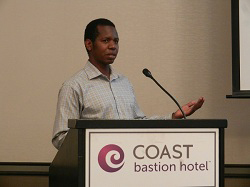The Seaweed and Integrated Multi-Trophic Aquaculture (IMTA) Research Laboratory of
Dr. Thierry Chopin
David Thumbi
Postdoctoral Fellow: 2012 - 2015
Co-supervisors: Shawn Robinson, Fisheries and Oceans Canada, St. Andrews, NB, Canada
Ben Forward, Research and Productivity Council, Fredericton, NB, Canada
2012-2014: Assessment of the bacterial community profiles at an Integrated Multi-Trophic Aquaculture (IMTA) site in New Brunswick and potential applications
Abstract:An assessment of microbial community profiles in the water column and benthic samples using Denaturing Gradient Gel Electrophoresis (DGGE) and DNA sequencing was conducted at an integrated multi-trophic aquaculture (IMTA) site in the Bay of Fundy, New Brunswick. The aim of the study was to determine seasonal dynamics in bacterial abundance and diversity and their roles in nutrient recycling in open-water IMTA systems. Both water and sediment samples were collected on spatial-temporal basis in 2012 and 2013. Initial analysis of surface water column samples collected spatially at various distances from the site revealed similar bacterial profiles suggesting homogenous bacterial diversity. Subsequent analysis of samples from various water column depths showed some seasonal variations in bacterial diversity. The most abundant species identified through sequencing of DNA from DGGE bands were distributed among the α–, β–, and γ–Protobacteria and Flavobacteria. The benthic samples showed significant spatial variations in bacterial profiles where some populations were dominant in the vicinity of the site and their abundance decreased at distances away from the site. DNA sequence data revealed species mainly in the d- and e-Protobacteria. Together, the results suggest that marine bacteria are highly diverse in the pelagic and benthic zones with each environment exhibiting unique and dominant species. This project makes a substantial contribution to understanding the spatial and temporal variations in bacterial communities surrounding an aquaculture site. Knowledge from this study will be used to develop a new bacterial-based monitoring tool for use alongside traditional measures of site impact. If successful, this study could help support a multivariate approach to aquaculture site monitoring and assessment.
2014-2015: Development and application of a bacterial-based assay for monitoring benthic environment at Integrated Multi-Trophic Aquaculture sites (IMTA)
Abstract: This study reports the development and application of a bioassay for assessing sediments collected from various aquaculture sites in the Bay of Fundy, New Brunswick. The study is part of CIMTAN-NSERC Strategic Network Enhancement Initiative (SNEI) and is built upon studies that identified patterns of sulfur-reducing bacteria (SRB) associated with the benthic zone beneath an aquaculture site. Owing to their significant ecological role in mineralization of nutrients in marine surface sediments, a culture-based assay for quantifying SRB was developed for use in site monitoring alongside other traditional measurements. The assay was developed using selective and differential growth factors for SRB enrichment from sediment samples. Both agar plate and most probable number methods (MPN) were used in the initial analysis. Data suggested that the MPN method was suitable for rapid quantification of SRB from sediment samples. Further optimization was conducted by utilizing media containing low agar concentrations and diverse substrates including; acetate, lactate, butyrate, and propionate. Results indicated that low agar concentration (‹ 0.5%) and mixed substrates supported relatively high levels of SRB. To validate the assay, sediments were collected from different aquaculture sites and quantified for sulfide concentrations and SRB counts. Here, three samples were collected at multiple stations and locations. Data from six sites showed average sulfide and SRB levels ranging from 69.2 - 1040 ÁM and 4.7- 464 MPN/g, respectively. There was a correlation between SRB and increasing sulfide levels, but this observation was not consistent across all sites perhaps due to a lack of high sulfides at the sites. Collectively, results suggest that this culture-based assay could be used as a tool for monitoring benthic environment in and around aquaculture sites. Knowledge from this study could help support a multivariate approach to benthic environmental management programs for aquaculture operations.

 Accessible Version
Accessible Version